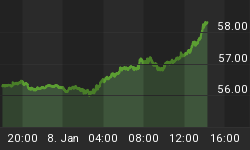As pretty much everyone knew they would, Congress and the president have stitched together a sad little "deficit reduction" plan that allows them to keep borrowing through the next election. But the details are less important than the timing, which coincides with what might be the start of a double dip recession. Consider this (slightly technical but well-done analysis) from Consumer Metrics Institute, which explains that the Great Recession was actually a lot deeper than originally reported and that it might not be over:
Included in the Bureau of Economic Analysis' first ("Advance") estimate of second quarter 2011 GDP were significant downward revisions to previously published data, some of it dating back to 2003. Astonishingly, the BEA even substantially cut their annualized GDP growth rate for the quarter that they "finalized" just 35 days ago -- from an already disappointing 1.92% to only 0.36%, lopping over 81% off of the month-old published growth rate before the ink had completely dried on the "final" in their headline number. And as bad as the reduced 0.36% total annualized GDP growth was, the "Real Final Sales of Domestic Product" for the first quarter of 2011 was even lower, at a microscopic 0.04%.
And the revisions to the worst quarters of the "Great Recession" were even more depressing, with 4Q-2008 pushed down an additional 2.12% to an annualized "growth" rate of -8.90%. The first quarter of 2009 was similarly downgraded, dropping another 1.78% to a devilishly low -6.66% "growth" rate. And the cumulative decline from 4Q-2007 "peak" to 2Q-2009 "trough" in real GDP was revised downward nearly 50 basis points to -5.14%, now officially over halfway to the technical definition of a full fledged depression.
Unfortunately, meaningful quarter-to-quarter comparisons are nearly impossible in light of the moving target provided by the revisions. But among the notable items are:
- Aggregate consumer expenditures for goods was contracting during the second quarter, with annualized demand for durable goods dropping 4.4% during the quarter -- into the ballpark of the numbers we have measured here at the Consumer Metrics Institute. This decline was enough to shave 0.35% off of the overall GDP (with just automotive goods removing 0.65% from the annualized GDP growth rate).
- The drag on the GDP from governmental cutbacks purportedly moderated by a full percent, improving to a -0.23% drag from a revised -1.23% impact in the first quarter. This reversal may be the result of either the waning effect of expiring stimuli or overly optimistic BEA "place-holders" while more data gets collected. Many state and local public sector employees would be shocked to learn that real-world governmental downsizing has moderated.
- Net foreign trade added 0.58% to the GDP growth rate after subtracting 0.34% during 1Q-2011 (a 0.92% positive swing) -- all in spite of oil prices reaching recent peaks at the end of April. Anomalies in imports caused by tsunami suppressed trade with Japan may have been the culprit here, since the growth rate in exports (and their contribution to the overall GDP growth) actually dropped quarter-over-quarter. Imports reportedly pulled overall GDP down by only 0.23%, after subtracting 1.35% from the revised figures for the prior quarter.
And here's the outline of the deficit plan:
Obama: Congressional Leaders Approve Debt-Limit Increase
President Barack Obama said tonight that leaders of both parties in the U.S. House and Senate had approved an agreement to raise the nation's debt ceiling and cut the federal deficit that must now be sold to Congress.
"The leaders of both parties in both chambers have reached an agreement that will reduce the deficit and avoid default," Obama said at the White House. "This compromise does make a serious down payment on the deficit-reduction we need. Most importantly it will allow us to avoid default."
The framework would raise the $14.3 trillion debt ceiling through 2012, and call for enactment of a law shaving another $1.5 trillion from long-term debt by 2021 -- or institute punishing reductions across all government areas, including Medicare and defense programs, according to congressional officials.
Some thoughts:
Those massive revisions in GDP have less to do with BEA incompetence or the opacity of the data than with the fact that people tend to focus on the first number they see. This allows the government to overstate growth up-front, and then dribble out the real, much weaker numbers over time, safe in the knowledge that most voters have already formed a favorable (or less unfavorable) opinion and are no longer paying attention. In other words, like those fake inflation and unemployment numbers, this is just another way that they're lying to us.
There are two other key things to understand about this and pretty much every other deficit reduction plan being discussed around the world: First, sitting governments can't obligate future ones. So the only number that matters is the current-year reduction, and this one is miniscule.
Second, even if all the proposed savings happen, it's still barely a rounding error for a US government that will continue to pile up several trillion dollars of new obligations each year.
But this deal does matter in one significant way: It will produce a bit less fiscal stimulus in the near term. Not enough to make much of a difference to a normal economy, but since the US is apparently in the process of dropping back into recession, it adds a bit of momentum to the already-reaccelerating debt destruction process. For those with access to the New York Times, here's a long piece that fleshes out the thesis.
















